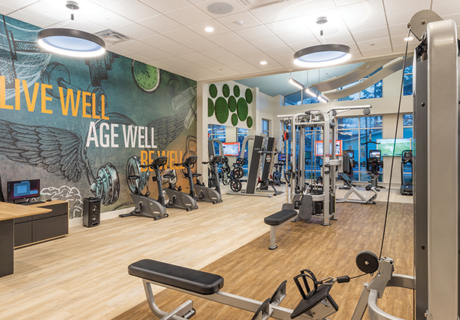Checking In On CCRCs
How does the type of senior living community chosen by seniors influence their overall health and wellness? The Mather LifeWays Institute on Aging and Northwestern University are one year into a five-year study to answer that question, specifically quantifying the benefits of continuing care retirement communities (CCRCs).
The main goal of The Age Well Study is to assess the impact of CCRC living on residents’ health and wellness over time and to provide data that can support and inform senior living design for years to come by identifying which organizational factors, such as size or amenities, are associated with more positive outcomes for residents.
Eighty CCRCs and more than 5,000 residents are participating in the study, with data being collected annually to look at changes in residents’ wellness over time. Results from the first year of the study, conducted from January to May 2018, were recently released. Participants completed surveys to assess their health and wellness in areas relating to emotional, social, physical, spiritual, intellectual, and vocational wellness, while staff were surveyed on organizational characteristics.
Residents’ input was then compared with responses from 1,000 older adults in the community at large who were comparable in terms of age,
income, and race/ethnicity. A subsequent report will examine interview data, which captures residents’ perspectives on health and wellness within a CCRC.
Findings from the first year suggest that CCRC residents are aging well, with more favorable scores on most measures of physical, social, and intellectual wellness compared to older adults living in the general population. For example, measuring satisfaction with life on a scale of 1-7, CCRC residents report high levels of satisfaction with life on average (5.84) compared to other seniors in the community at large (5.34). Looking at perception of aging, on a scale of 1-6, seniors’ outlook was also more positive at CCRCs (4.01) compared to community-at-large older adults (3.64).
In four out of five facets of physical wellness, residents of CCRCs outscored their counterparts in the community at large. While the study is not intended to reveal explanations for why certain patterns exist, the researchers did offer some theories, including noting that the presence of fitness centers and wellness services at CCRCs likely contributes to the difference.
Of the CCRCs participating in the study, 98 percent have a fitness center, 85 percent house a swimming pool,and 100 percent commonly offer group exercise, which makes wellness resources more convenient to residents than those in the community who may have greater barriers to participation when seeking similar resources.
The study also found some associations related to organizational characteristics and resident emotional wellness. Specifically, residents from larger communities of 300-plus residents reported greater life satisfaction, more positive moods and perceptions of aging, less stress, and greater perceived control than those living in communities of 1-300 residents. The authors noted that this may be associated with the fact that larger communities generally have more resources that have a positive impact on residents; however, specific amenities or quantity of amenities weren’t associated with these outcomes.
Another notable finding was the link between emotional wellness and region of the country, with residents in the South and West reporting greater life satisfaction and more optimism than those in the Midwest and Northeast. One influence on these outcomes, researchers noted, could be the fact that communities in these regions are generally larger and thus have greater availability of resources.
When asked about the perceived impact of moving to a CCRC on wellness, 69 percent of residents reported that moving “somewhat or greatly improved” their social wellness, with another 25 percent saying it was unchanged.
As data from the study begins to paint a picture of how residents are affected by living in a CCRC, future years’ studies will look at changes in wellness outcomes over time among CCRC residents compared to those in the general population. To download the full report, visit www.matherlifewaysinstituteonaging.com/agewellstudy.




